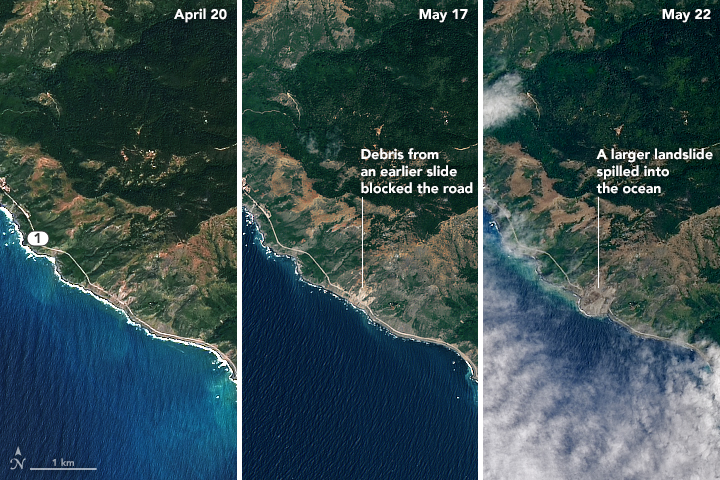
Jaw-dropping before-and-after satellite images capture the magnitude of a massive landslide along California's Big Sur coastline.
The landslide, which sent more than 1 million tons of rocks and dirt across California's scenic coastal Highway 1, occurred on the night of May 20. Before the huge rockfall, a smaller one occurred earlier in the spring.
"This is a large slide preceded by smaller slides, which is not uncommon," Thomas Stanley, a geologist and researcher for NASA, said in a statement. “Much of the California coastline is prone to collapse, so it’s fortunate that this landslide happened in an unpopulated location.”
The dramatic collapse covered about 0.3 miles (0.5 kilometers) of the scenic byway in 35 to 40 feet (10.6 to 13.7 meters) of rubble. It also created 16 acres of land that jut out from the Big Sur coastline, the San Jose Mercury News reported.
The massive landslide was captured in images taken by the Operational Land Imager (OLI) on Landsat 8, an Earth-observing satellite operated by NASA and the U.S. Geological Survey. The before picture was captured on April 22, while images of the smaller rock slide were taken on May 17 and the massive slide was captured on May 22.
The massive landslide could close Highway 1 for a year, according to Caltrans, the California department of transportation.
The area is still vulnerable to further landslides.
Get the Space.com Newsletter
Breaking space news, the latest updates on rocket launches, skywatching events and more!
“There's still little rocks coming down and you can hear it," Susana Cruz, a Caltrans spokeswoman, told the San Jose Mercury News.
Originally published on Live Science.
Join our Space Forums to keep talking space on the latest missions, night sky and more! And if you have a news tip, correction or comment, let us know at: community@space.com.

Tia is the assistant managing editor and was previously a senior writer for Live Science, a Space.com sister site. Her work has appeared in Scientific American, Wired.com and other outlets. She holds a master's degree in bioengineering from the University of Washington, a graduate certificate in science writing from UC Santa Cruz and a bachelor's degree in mechanical engineering from the University of Texas at Austin. Tia was part of a team at the Milwaukee Journal Sentinel that published the Empty Cradles series on preterm births, which won multiple awards, including the 2012 Casey Medal for Meritorious Journalism.










